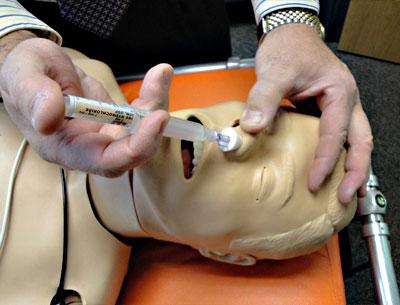New Protocol for Drug Overdoses

A drug that can reverse the effects of life-threatening overdoses of the opioid drugs heroin, morphine, and oxycodone, which was for many years available only in emergency rooms, is now being used by emergency medical service providers throughout Suffolk County and will soon be available to South Fork police departments.
Narcan, the brand of naloxone most frequently used, is administered when a patient is believed to have taken a drug that has depressed the central nervous or respiratory systems. Until recently, only paramedics were able to administer it, and they did so intravenously or intra-muscularly in the field. As basic life support providers, emergency medical technicians now can provide the time-sensitive intervention through a patient’s nose. A patient can regain consciousness within minutes. If a patient is already in cardiac arrest, however, it can no longer be administered.
The benefits are two-fold, according to Tom Lateulere, the chief of education and training for Suffolk County Emergency Services. “Opioid overdoses have no boundaries. When you’re talking about a drug that can stop somebody from breathing within seconds, this gives the person the best chance of resuscitation,” he said. The potential for a needle-stick injury is also greatly reduced with the use of the antidote through the nose.
The change comes as the county reported a 300-percent rise in heroin-caused deaths over the last four years. In 2013, there were at least 82 heroin deaths, and possibly more; the county medical examiner’s figures are incomplete due to ongoing police investigations. In 2012, there were 83, while in 2011 there were 64 and in 2010 just 37.
The decision to make naloxone part of the standing orders for E.M.T.s in Suffolk County came after a pilot program in 2012. In 223 opioid overdoses treated under the program, there were no adverse reactions and no significant hazards to the emergency medical personnel, according to the State Department of Health. Mr. Lateulere said Narcan was administered 108 times in 2013. In October that year, the New York State Emergency Medical Advisory Committee approved intranasal administration of naloxone through a mucosal atomizer. The liquid solution is pushed through a padded, porous head with half of it administered through each nostril.
The experiment was supposed to last two to three years, but it was believed to have saved so many lives that the decision to make it part of standing orders for E.M.T.s and get it into the hands of more police officers, and even the public, was made in a year’s time instead. Most of the E.M.T.s on the South Fork received training last month, and police departments are now signing up for it.
East Hampton Village Police Chief Gerard Larsen said all 25 officers in his department will receive certification when the village holds a training session on May 21. Though there have not been any heroin overdoses in his jurisdictionin recent memory, he considers it only a matter of time. “If it can save one life, it will be worth it,” he said.
Town police officers will also receive the training later this month. Town Police Chief Michael Sarlo said his department would get as many officers certified as possible, and he will look into hosting another training session for others.
Chief Sarlo, whose department covers a much larger area than Chief Larsen’s, said heroin is definitely a problem in the town of East Hampton, though he stopped short of calling it an epidemic — a term used by many to describe its use farther west on Long Island. Going back to 2009, there have been 49 calls classified as overdoses, although only 5 or 6 were from heroin. Some were the result of alcohol poisoning and quite a few were from prescription drugs. Only a handful have been fatal, Chief Sarlo said. He said that his department’s records management system was being improved to better track overdoses.
“It’s an issue. We have had several overdoses. Heroin has come and gone in waves in recent years. It seems to be more prevalent now,” he said, noting the cost and ease of obtaining “a quick fix.”
Last month, Justin Bennett, a former Springs resident, pleaded guilty to a string of burglaries throughout town, which he said were to feed a heroin addition after he got hooked on prescription drugs. In February, the East End Drug Task Force, which was recently formed, arrested nine street dealers from Riverhead who were allegedly selling and buying an especially potent heroin that was traced to at least half a dozen overdoses on the South Fork, including in Sag Harbor and Bridgehampton.
“There’s a whole new generation looking to heroin, which is troublesome,” Chief Sarlo said. “All communities are dealing with it. We’re always actively investigating the drug trade in our community.”
The administration of Narcan is so simple, in fact, that the public is being trained to use it too. Two weeks ago, Suffolk County Executive Steve Bellone, New York Senator Phil Boyle, and the Suffolk County Department of Health announced a partnership in Opioid Prevention Training.
“Through government and community partnerships, we can expand the pool of future first responders and equip them with the training they need to respond to opioid overdoses,” Mr. Bellone said. “Narcan has shown time and again the ability to reverse the effects of an overdose and give those individuals a second chance at life.”
